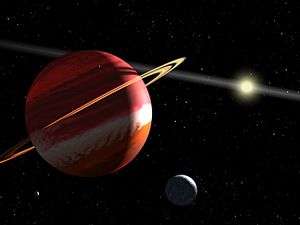Epsilon Eridani b
| Exoplanet | List of exoplanets | |
|---|---|---|
 | ||
| Parent star | ||
| Star | Epsilon Eridani | |
| Constellation | Eridanus | |
| Right ascension | (α) | 03h 32m 55.8442s[1] |
| Declination | (δ) | −09° 27′ 29.744″[1] |
| Apparent magnitude | (mV) | 3.73 |
| Distance | 10.475±0.003[1] ly (3.212±0.001[1] pc) | |
| Spectral type | K2V[2] | |
| Orbital elements | ||
| Semi-major axis | (a) | ~3.4 AU |
| Orbital period | (P) | ~2500 d |
| Physical characteristics | ||
| Mass | (m) | ~1.56 MJ |
| Discovery information | ||
| Discovery date | 7 August 2000 | |
| Discoverer(s) | Hatzes et al. | |
| Discovery method | Doppler spectroscopy | |
| Discovery site | United States | |
| Discovery status | Proposed | |
| Other designations | ||
AEgir, 18 Eridani b, Gliese 144 b, HD 22049 b, HIP 16537 b, HR 1084 b | ||
| Database references | ||
| Extrasolar Planets Encyclopaedia | data | |
| SIMBAD | data | |
| Exoplanet Archive | data | |
| Open Exoplanet Catalogue | data | |
Epsilon Eridani b or AEgir[lower-alpha 1] is a proposed and unconfirmed extrasolar planet approximately 10 light-years away orbiting the star Epsilon Eridani, in the constellation of Eridanus (the River).
The planet and its host star are one of the planetary systems selected by the International Astronomical Union as part of their public process for giving proper names to exoplanets and their host star (where no proper name already exists).[3][4] The process involved public nomination and voting for the new names.[5] In December 2015, the IAU announced the winning names were AEgir for the planet and Ran for the star.[6] James Ott, age 14, submitted the names for the IAU contest and won.[7]
Discovery
The planet's existence was suspected by a Canadian team led by Bruce Campbell and Gordon Walker in the early 1990s, but their observations were not definitive enough to make a solid discovery. Its formal discovery was announced on August 7, 2000 by a team led by Artie Hatzes. The discoverers gave its mass as 1.2 ± 0.33 times that of Jupiter, with a mean distance of 3.4 AU from the star.[8] Observers, including Geoffrey Marcy, suggested that more information on the star's Doppler noise behaviour created by its large and varying magnetic field was needed before the planet could be confirmed.[9]
In 2006, the Hubble Space Telescope made Astrometric measurements and confirmed the existence of the planet.[10] These observations indicated that the planet has a mass 1.5 times that of Jupiter and shares the same plane as the outer dust disk observed around the star.[11] The derived orbit from these measurements is eccentric: either 0.25[11] or 0.7.[12]
Meanwhile, the Spitzer Space Telescope detected an asteroid belt at roughly 3 AU from the star.[13] In 2009 Brogi's team claimed that the proposed planet's eccentricity and this belt were inconsistent: the planet would pass through the asteroid belt and rapidly clear it of material.[14]
The planet and the inner belt may be reconciled if that belt's material had migrated in from the outer comet belt (also known to exist).[15]
See also
Notes
References
- 1 2 3 4 van Leeuwen, Floor (November 2007), "Validation of the new Hipparcos reduction", Astronomy and Astrophysics, 474 (2): 653–66, arXiv:0708.1752v1, Bibcode:2007A&A...474..653V, doi:10.1051/0004-6361:20078357.
- ↑ Gray, R. O.; et al. (July 2006), "Contributions to the Nearby Stars (NStars) Project: spectroscopy of stars earlier than M0 within 40 pc-The Southern Sample", The Astronomical Journal, 132 (1): 161–170, arXiv:astro-ph/0603770, Bibcode:2006AJ....132..161G, doi:10.1086/504637.
- ↑ "NameExoWorlds: An IAU Worldwide Contest to Name Exoplanets and their Host Stars". IAU.org. 9 July 2014. Retrieved 2017-09-25.
- ↑ "The ExoWorlds". nameexoworlds.iau.org: IAU. Retrieved 2017-09-25.
- ↑ "NameExoWorlds". nameexoworlds.iau.org: IAU. Retrieved 2017-09-25.
- ↑ "Final Results of NameExoWorlds Public Vote Released". International Astronomical Union. 15 December 2015. Retrieved 2017-09-25.
- ↑ "Mountainside wins competition to name planet, star". Spokesman.com. Retrieved 2016-05-12.
- ↑ Hatzes, Artie P.; et al. (2000). "Evidence for a Long-Period Planet Orbiting ε Eridani". The Astrophysical Journal. 544 (2): L145–L148. arXiv:astro-ph/0009423. Bibcode:2000ApJ...544L.145H. doi:10.1086/317319.
- ↑ Marcy, Geoffrey W.; et al. (August 7–11, 2000). "Planetary Messages in the Doppler Residuals (Invited Review)". In A. Penny. Planetary Systems in the Universe, Proceedings of IAU Symposium #202. Manchester, United Kingdom. p. 20–28. Bibcode:2004IAUS..202...20M.
- ↑ "Hubble Zeroes in on Nearest Known Exoplanet". Hubble News Desk. 2006-10-09. Retrieved 2006-10-10.
- 1 2 Benedict; et al. (2006). "The Extrasolar Planet ε Eridani b: Orbit and Mass". The Astronomical Journal. 132 (5): 2206–2218. arXiv:astro-ph/0610247. Bibcode:2006AJ....132.2206B. doi:10.1086/508323. Retrieved 2008-11-16.
- ↑ Butler; et al. (2006). "Catalog of Nearby Exoplanets". The Astrophysical Journal. 646: 505–522. arXiv:astro-ph/0607493. Bibcode:2006ApJ...646..505B. doi:10.1086/504701.
- ↑ Backman, D.; et al. (2009). "Epsilon Eridani's Planetary Debris Disk: Structure and Dynamics Based on Spitzer and Caltech Submillimeter Observatory Observations". The Astrophysical Journal. 690 (2): 1522–1538. arXiv:0810.4564. Bibcode:2009ApJ...690.1522B. doi:10.1088/0004-637X/690/2/1522.
- ↑ Brogi, M.; et al. (2009). "Dynamical stability of the inner belt around Epsilon Eridani". Astronomy and Astrophysics. 499 (2): L13–L16. Bibcode:2009A&A...499L..13B. doi:10.1051/0004-6361/200811609.
- ↑ Martin Reidemeister; et al. (2010). "The cold origin of the warm dust around epsilon Eridani". Astronomy & Astrophysics. 527: A57. arXiv:1011.4882. Bibcode:2011A&A...527A..57R. doi:10.1051/0004-6361/201015328.